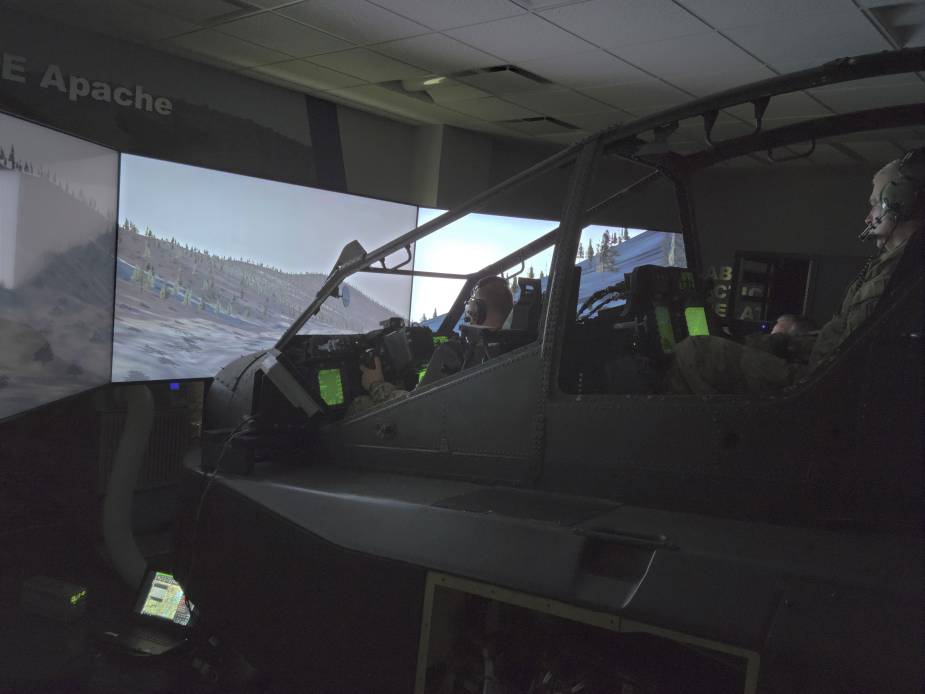Breaking news
Integration Lab supports US Army aviation modernization.
The Program Executive Office (PEO) Aviation Combat Aviation Brigade (CAB) Architecture Integration Lab (CABAIL) conducted its first Technology Insertion Event (TIE) June 21 to 25, at Redstone Arsenal, Ala, the US Army reports on its website. The event’s purpose was to incorporate maturing technologies and products from selected industry vendors into a simulated aviation force to explore and examine their relative operational value.
Follow Air Recognition on Google News at this link

Chief Warrant Officer 5 Daniel Piland (r) and Chief Warrant Officer 2 Stephen Burns, both AH-64 Apache helicopter pilots with the N.C. ARNG, conduct a simulated mission during CABAIL TIE 21-1. (Picture source: U.S. Army/David Hylton)
The CABAIL staff teamed with groups from the Redstone Test Center (RTC) and the U.S. Army Combat Capabilities Development Command Aviation & Missile Center to develop, organize, and conduct this TIE. Aircrews and staff personnel from Army National Guard (ARNG) units of three states (Tennessee, Georgia, and North Carolina) provided the personnel for the event.
"We’re helping determine what the future aviators could get to further their situational awareness," said 1st Lt. Andrew Rines, a Black Hawk pilot with the Tennessee Army National Guard. "An overall ability to influence the battlefield is critical for engagements we may face in the future," he added.
The four Apache pilots from the North Carolina Army National Guard said they very excited to have the opportunity to test new equipment and have a positive impact on Army Aviation. They continued, the capabilities of the systems we used are a step forward to keep the Army integrated with other services and therefore more capable in the Joint All Domain Operational environment. They hope that this testing helps Army leaders make a well informed decision on the purchase of these types of systems and that the warfighter gets these systems in a timely manner.
Three cadets from the US Military Academy at West Point also provided support by collecting and reducing captured performance data. “Spending time with CABAIL has changed my perspective about how technologies in the Army are integrated,” said Cadet Rory Blankenship, USMA ’22, “I think if warfighters start demanding to see specific changes in the technology they’re using, acquisitions will respond.”
PEO Aviation developed the CABAIL to support the modernization of the CAB as a lethal maneuver force in support of Multi-Domain Operations. The integrated environment is used to support both the Army’s enduring aviation platforms and future fleets.
The CABAIL includes multiple high-fidelity aircraft Systems Integration Labs (SILs) and AH-64E, UH-60L, UH-60M, CH-47F, and the MQ-1C and RQ-7B Ground Control Stations simulators. It also includes a functional CAB Tactical Operations Center with actual mission command systems and radios; a Networks Integration Center that enables connectivity among the CABAIL entities; and a hub, developed by RTC, known as Battle Master that coordinates and manages the scenarios as well as collects systems’ performance data.
The CABAIL approximates the interoperability and operational capabilities of a CAB in selected aviation mission-set vignettes by combining manned and virtual entities with operator-directed, constructive simulation of other aircraft and combat systems. This total capability approach facilitates accelerated systems integration of new and emerging technologies for concept exploration as well as measuring the operational relevance of maturing technologies and products for the CAB.
In preparation for the TIE, the CABAIL office sent aviation defense industry members a request for information on maturing technologies and applicable systems. The industry vendors responded with almost 80 proposals. In conjunction with the appropriate PEO AVN project management offices, the CABAIL team selected 11 vendor systems to explore and examine in the CABAIL TIE. The selected systems and capabilities included voice and data communications, in-cockpit weather displays, a reconfigurable cockpit display, air launched effects control, and aircrew data tablet displays. The participating aircrews received training on these systems prior to their use in the respective CABAIL SILs and simulation devices.
The aircrews and staff personnel planned and executed two CAB mission sets using relevant to operational air assault scenarios and vignettes. They conducted these missions as a collective force in a simulated high-intensity combat environment of a real-world Joint contingency theater of operation that included JSTARS surveillance aircraft, F/A-18 multirole combat jets and naval gunfire.
The aircrews flew the first set of missions with current aircraft mission equipment with the USMA cadets collecting the performance data. An Operational Research and Systems Analysis (ORSA) specialist reviewed the data and established an initial performance baseline. Then the aircrews flew the missions again but this time with the selected vendor systems included in the configuration of their respective aircraft SILs and simulators.
Using data collected from the second set of missions, the ORSA specialist and the cadets produced new data sets for comparison with the baseline performance data. The aircrews and staff personnel also provided subjective assessments regarding the effect that the added capabilities of the new systems had on operational effectiveness.
The staff will provide these quantitative and qualitative assessments to the vendors, as well as submit a comprehensive event report to the PEO leadership. Follow-on CABAIL efforts will inform the Aviation Enterprise on the potential of new and existing technologies for current force aircraft and shape the capabilities of Future Vertical Lift platforms.


























